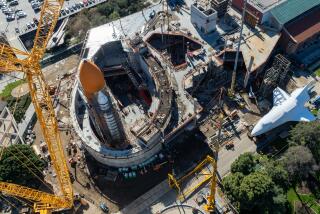Endeavour Crew Checks Up on Self-Stabilizing Satellite
- Share via
HOUSTON — Like an 80-pound dart orbiting Earth at 17,500 mph, a test satellite had steadied itself to fly heavy-end-forward when the space shuttle Endeavour’s astronauts crept up to check its progress Saturday.
Astronauts released the wastebasket-size probe Wednesday and returned to hover within about 1,700 feet of the craft for 6 1/2 hours of observations.
The satellite is designed to stabilize itself without the use of rocket motors by using the Earth’s magnetic field, its mass and the very thin atmosphere 176 miles up.
It appeared to be working just as researchers hoped after three days of free flight.
“The weighted end is traveling forward as we anticipated,” said NASA project manager Neal Barthelme. “We’re very excited.”
With astronauts John Casper and Curt Brown at the controls, Endeavour approached the black-and-white striped satellite about 1 a.m. PDT.
Both radar data and observations by the astronauts indicated that the satellite’s flight path was mostly straight, with a slight wobble. It was released with an intentional 90-degree pitch.
“[It] appears to be much more stable than it was the other day,” astronaut Daniel Bursch told Mission Control.
Researchers were unable, however, to determine the satellite’s precise stability because of trouble with a laser-measurement system riding in Endeavour’s cargo bay.
The system is supposed to measure the satellite’s wobble by bouncing laser beams off reflectors on either end of the cylindrical craft. Although there were periodic indications it was working, the device repeatedly gave false readings.
Casper, the mission commander, tilted the shuttle several times to improve laser reflection angles, but the tracking device never locked onto the satellite properly.
Principal investigator Linda Pacini said the system might have been confused by light reflected off a surface other than its intended target, possibly even another object in the cargo bay.
“We’re really not sure what the problem is,” she said. “We’re coming up with a set of tests right now to try and determine that.”
The National Aeronautics and Space Administration rescheduled another shuttle-satellite rendezvous from today to Monday so researchers would have more time to study the problem. Pacini said the delay also would allow the satellite time to further steady its course. The wobble should be gone by Monday, she said.
Researchers insisted that they would consider the $600,000 experiment a success even without the precise laser tracking data.
Through radar data, the satellite’s wobble can be determined within 2 degrees, while the laser could narrow that margin of error to less than one-tenth of a degree, Pacini said.
“We would like to get the laser data because it’s more accurate, but we’ll still be able to prove the two concepts . . . just with the radar data,” she said.
The satellite--14 inches in diameter and 20 inches long--is weighted with bronze on one end and is equipped with two magnetic rods. The goal is to prove that the Earth’s magnetic field and a spacecraft’s own mass should provide automatic stability.
If it works, future satellites could be launched without heavy--and expensive--jet thrusters and fuel tanks.
The satellite won’t be along for the ride when Endeavour heads home Wednesday. Having done its job, the craft will be left to burn up in Earth’s atmosphere late this summer.
Endeavour’s crew is now more than halfway into its 10-day flight. The shuttle is scheduled to land at Florida’s Kennedy Space Center.
More to Read
Sign up for Essential California
The most important California stories and recommendations in your inbox every morning.
You may occasionally receive promotional content from the Los Angeles Times.













